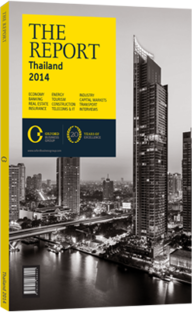PTT Global Chemical: Petrochemicals
The Company
PTT Global Chemical was set up on October 19, 2011 through the successful amalgamation of PTT Chemical and PTT Aromatics and Refining to be the chemical flagship of the PTT Group. Currently, the company has become a world-scale petrochemicals and refining producer with integrated olefins and aromatics production capacity of some 8.72m tonnes per annum and petroleum production capacity of around 280,000 barrels per day.
The integration has strengthened the company in terms of 1) its competitive advantage, particularly from economies of scale and economical gas-based feedstock; 2) earnings stability based on greater product diversification in the olefins and aromatics lines, as well as more value-added downstream specialties to reduce the risk inherent in the petrochemicals industry; and 3) solid financial leverage with room to pursue further investment expansion. Apart from the aforementioned strengths, the integration has brought about increasing synergy benefits, boosting EBITDA by $230m in 2013. This synergy has been underpinned by operational excellence (including cost reductions and yield improvement) and marketing excellence (product development and customer portfolio management), as well as other synergy projects (through feedstock optimisation and product value enhancement).
Development Strategy
Based on the company’s 2013 EBITDA of $1.8bn (+19% compound annual growth rate in 2011-13), the olefins and olefins derivatives business is still its major EBITDA contributor at around 60%, followed by aromatics at 21% and the refinery business at 11%. Meanwhile, green products, high-value specialties (HVS) and other products contribute 8%. The company has built up its long-term growth platform in order to strengthen its core uplift in parallel with investment expansion focusing on new products and geographic locations. This will enable the company to cover the full chain of products, shifting from a majority of commodity-grade products at present to a high proportion of HVS and bioplastic products in the future.
Under the core uplift programmes, the company has focused on operational excellence, marketing excellence and synergy benefits, with debottlenecking projects (both for the ethane cracker and downstream plants) targeted to bear fruit during second-half 2015-17E.
Meanwhile, its one-step adjacencies are concentrated on new products, including the polycarbonate and polyurethane chain, and new geographic locations through projects with strategic partners. These joint-venture projects include a manufacturing joint venture for a petrochemicals complex in Indonesia with Pertamina (with a 51% stake held by Pertamina and a 49% stake held by PTTGC). Expected project costs of $5bn will cover both an upstream olefins cracker and a downstream plant (investment decision to be finalised in 2015E), targeted at the growing domestic Indonesian market (home to the world’s fourth-largest population at 230m people). It is also pursuing cooperation in trading activities in China with Sinochem, with a further possible joint venture in a downstream petrochemicals plant. Moreover, the firm has established a footprint in green products, including polylactic acid biopolymer (used for food containers), through a 50% stake acquisition in NatureWorks to gain technological know-how.
For all the planned investment expansion in the pipeline, the company calls for its five-year capital expenditures (capex) to reach $4.5bn during 2014-18E, with the largest portion (64%) to be used in the one-step adjacencies, 31% in the core uplift and the remaining 5% in green products. The total sum of $4.5bn in capex for the next five years is to be financed by the company’s cash flow from operation amounting to $2.5bn and by the issuance of debentures worth $2bn (with secured debentures worth $1bn year-to-date). We believe that its cash flow and financial position can facilitate these initiatives, which will result in EBITDA uplift in the long run. Given its low net debt-to-equity and net debt-to-EBITDA, at 0.14x and 0.62x (ending FY2014E), and policy thresholds of 0.7x and 2.4x, respectively, PTTGC can raise debt without a capital increase in this period.
You have reached the limit of premium articles you can view for free.
Choose from the options below to purchase print or digital editions of our Reports. You can also purchase a website subscription giving you unlimited access to all of our Reports online for 12 months.
If you have already purchased this Report or have a website subscription, please login to continue.

